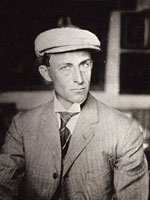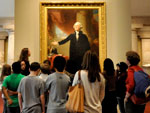1. Winter counts, kept by the Lakota people, mark each year in a Lakota band's history with a picture depicting an important event. For the year 1833, many Lakota winter counts show the same event: stars falling from the night sky.
True. In the winter of 1833, the Leonid meteor shower,  visible each November, blazed with extraordinary strength. The falling stars caught the attention of people throughout North America, and many Lakota bands chose the shower as the event to stand for the year. Later in the 1800s, ethnologist Garrick Mallery (1831-1894) identified the pictures as standing for the meteor shower, allowing scholars to match the years of the winter counts with the European calendar.
visible each November, blazed with extraordinary strength. The falling stars caught the attention of people throughout North America, and many Lakota bands chose the shower as the event to stand for the year. Later in the 1800s, ethnologist Garrick Mallery (1831-1894) identified the pictures as standing for the meteor shower, allowing scholars to match the years of the winter counts with the European calendar.
2. Prior to introduction to European calendar systems, the Native peoples of Alaska used peg calendars, wooden calendars in which a peg was moved forward in a series of holes day by day to mark the passage of time.
False. Russian colonists and missionaries  introduced peg calendars to the Native peoples of Alaska so that they could track the holy days of the Russian Orthodox Church. Russian contact with Alaskan cultures began in the 1700s, and settlement of the region, accompanied by cultural exchange, continued until 1867, when the U.S. purchased Alaska from the Russians. Peg calendars remained in use into the 20th century.
introduced peg calendars to the Native peoples of Alaska so that they could track the holy days of the Russian Orthodox Church. Russian contact with Alaskan cultures began in the 1700s, and settlement of the region, accompanied by cultural exchange, continued until 1867, when the U.S. purchased Alaska from the Russians. Peg calendars remained in use into the 20th century.
3. The Winnebago Native Americans recorded time using calendar sticks, in which notches were cut to signify important events, lunar cycles, years, and other units of distinction and division.
True. The Winnebago Native Americans did use sticks  to record the passing of time in this manner. However, the use of calendar sticks was not limited to the Winnebago. Other Native American groups throughout North America used sticks, including the Pima, the Osage, and the Zuni. The markings on sticks and their daily and ceremonial use varied from region to region and people to people.
to record the passing of time in this manner. However, the use of calendar sticks was not limited to the Winnebago. Other Native American groups throughout North America used sticks, including the Pima, the Osage, and the Zuni. The markings on sticks and their daily and ceremonial use varied from region to region and people to people.
4. The Hopi calendar divides the year into four sections. Spirits known as katsinas (or kachinas) visit the Hopi people in two of these sections, alternating with the two sections free of the spirits.
False. The Hopi calendar divides the year into two halves,  one beginning around the summer solstice (June 20th or 21st) and the other with the winter solstice (December 21st or 22nd). After the winter solstice, katsinam, benevolent spirits, visit the Hopi people, personated by Hopi men in masks and costumes. Following the summer solstice, the katsinam leave the Hopi again.
one beginning around the summer solstice (June 20th or 21st) and the other with the winter solstice (December 21st or 22nd). After the winter solstice, katsinam, benevolent spirits, visit the Hopi people, personated by Hopi men in masks and costumes. Following the summer solstice, the katsinam leave the Hopi again.
 visible each November, blazed with extraordinary strength. The falling stars caught the attention of people throughout North America, and many Lakota bands chose the shower as the event to stand for the year. Later in the 1800s, ethnologist Garrick Mallery (1831-1894) identified the pictures as standing for the meteor shower, allowing scholars to match the years of the winter counts with the European calendar.
visible each November, blazed with extraordinary strength. The falling stars caught the attention of people throughout North America, and many Lakota bands chose the shower as the event to stand for the year. Later in the 1800s, ethnologist Garrick Mallery (1831-1894) identified the pictures as standing for the meteor shower, allowing scholars to match the years of the winter counts with the European calendar. introduced peg calendars to the Native peoples of Alaska so that they could track the holy days of the Russian Orthodox Church. Russian contact with Alaskan cultures began in the 1700s, and settlement of the region, accompanied by cultural exchange, continued until 1867, when the U.S. purchased Alaska from the Russians. Peg calendars remained in use into the 20th century.
introduced peg calendars to the Native peoples of Alaska so that they could track the holy days of the Russian Orthodox Church. Russian contact with Alaskan cultures began in the 1700s, and settlement of the region, accompanied by cultural exchange, continued until 1867, when the U.S. purchased Alaska from the Russians. Peg calendars remained in use into the 20th century. to record the passing of time in this manner. However, the use of calendar sticks was not limited to the Winnebago. Other Native American groups throughout North America used sticks, including the Pima, the Osage, and the Zuni. The markings on sticks and their daily and ceremonial use varied from region to region and people to people.
to record the passing of time in this manner. However, the use of calendar sticks was not limited to the Winnebago. Other Native American groups throughout North America used sticks, including the Pima, the Osage, and the Zuni. The markings on sticks and their daily and ceremonial use varied from region to region and people to people. one beginning around the summer solstice (June 20th or 21st) and the other with the winter solstice (December 21st or 22nd). After the winter solstice, katsinam, benevolent spirits, visit the Hopi people, personated by Hopi men in masks and costumes. Following the summer solstice, the katsinam leave the Hopi again.
one beginning around the summer solstice (June 20th or 21st) and the other with the winter solstice (December 21st or 22nd). After the winter solstice, katsinam, benevolent spirits, visit the Hopi people, personated by Hopi men in masks and costumes. Following the summer solstice, the katsinam leave the Hopi again. The Smithsonian National Museum of Natural History's online exhibit
The Smithsonian National Museum of Natural History's online exhibit 


